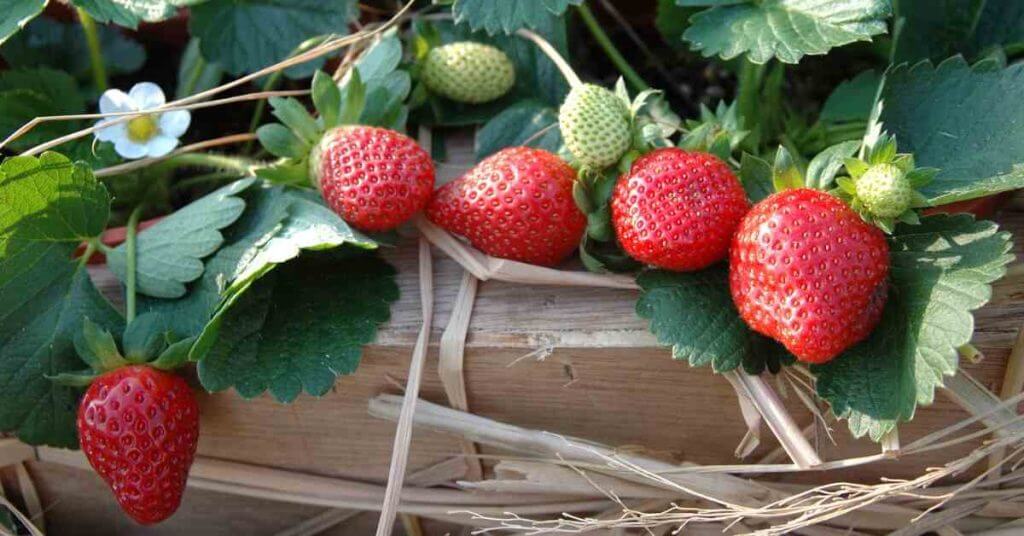
The 5 Best Companion Plants For Strawberries
Here are the 5 best companion plants for strawberries, and how each will compliment each other for healthier and more lucrative strawberries.
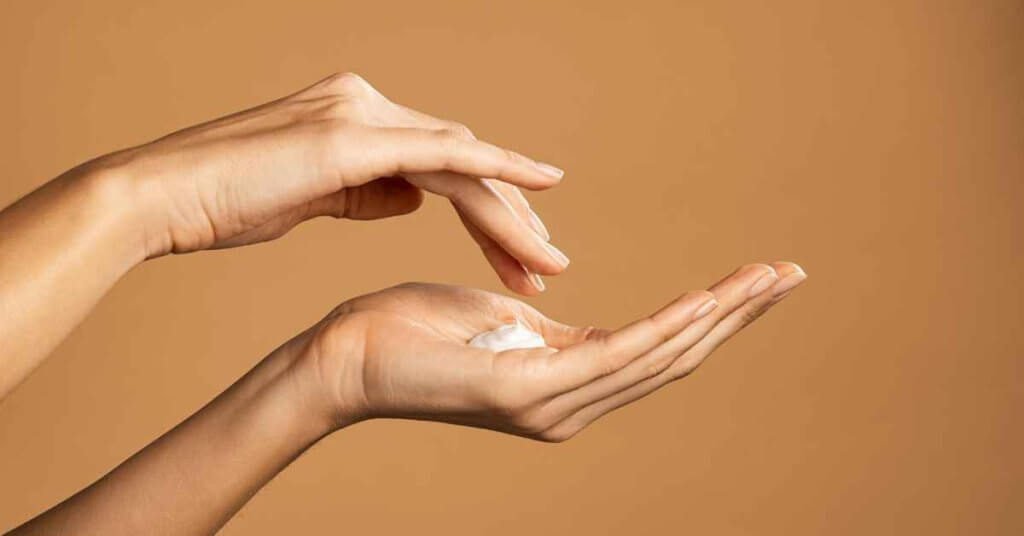
Tallow might not sound glamorous—it’s a solid fat sourced from ruminant animals like cows, goats, and sheep—but don’t let its humble origins fool you.
This centuries-old ingredient is making a comeback in skincare for a good reason. Packed with skin-loving fatty acids and vitamins, tallow closely mimics the natural oils our skin produces, offering unparalleled nourishment, hydration, and repair.
Rendered from organ fat (not the muscle fat found in steaks), tallow undergoes purification to become a clean, nutrient-dense product suitable for everything from cooking to skincare. Its high concentration of stearic and oleic acids, along with fat-soluble vitamins like A, D, and E, makes it a powerhouse for maintaining and restoring skin health.
Whether you’re battling dry, irritated, or acne-prone skin, or simply looking for a deeply hydrating, natural solution, tallow delivers what your skin truly needs. Let’s dive into the science, benefits, and why this ancient remedy is reclaiming its place as a modern skincare essential.
Tallow is a solid fat derived from ruminant animals such as cows, goats, and sheep, which have specialized digestive systems that allow them to break down fibrous plant material efficiently.
At GreenStead Living, we craft our tallow from grass-fed and finished beef suet—the dense, nutrient-rich fat found around the kidneys and loins of cattle. This high-quality suet forms the foundation for creating the finest tallow products.
Beef tallow is the preferred choice for most tallow-based skincare products due to its superior content of stearic and oleic acids, which set it apart from other ruminant tallows like those derived from sheep or goats. These fatty acids make it especially effective for moisturizing and closely mimicking human skin lipids, which play a vital role in strengthening the skin’s natural barrier.
Although the idea of raw animal fat might sound unappealing, the process of rendering transforms it into a clean, versatile fat. Rendering involves gently heating the suet to separate the pure tallow from impurities such as water, connective tissue, and proteins. The result is a purified, solid fat suitable for a variety of uses, including cooking, soap making, skincare, and even biofuels.
Here at Green Stead Living, we take this process a step further with our meticulous three-stage rendering method. This approach not only removes impurities but also eliminates residual water, which is often responsible for rancidity in less carefully prepared tallow. The result is a product that meets the highest standards of quality and purity.
When delving into the composition of tallow, it becomes immediately obvious that the tallow for use on the skin is as compatible as peanut butter and jelly.
Firstly, tallow is abundant in triglycerides, a type of lipid (fat) composed of three fatty acids: oleic acid, palmitic acid, and stearic acid. It also contains smaller yet significant amounts of other beneficial fatty acids, such as linoleic acid.
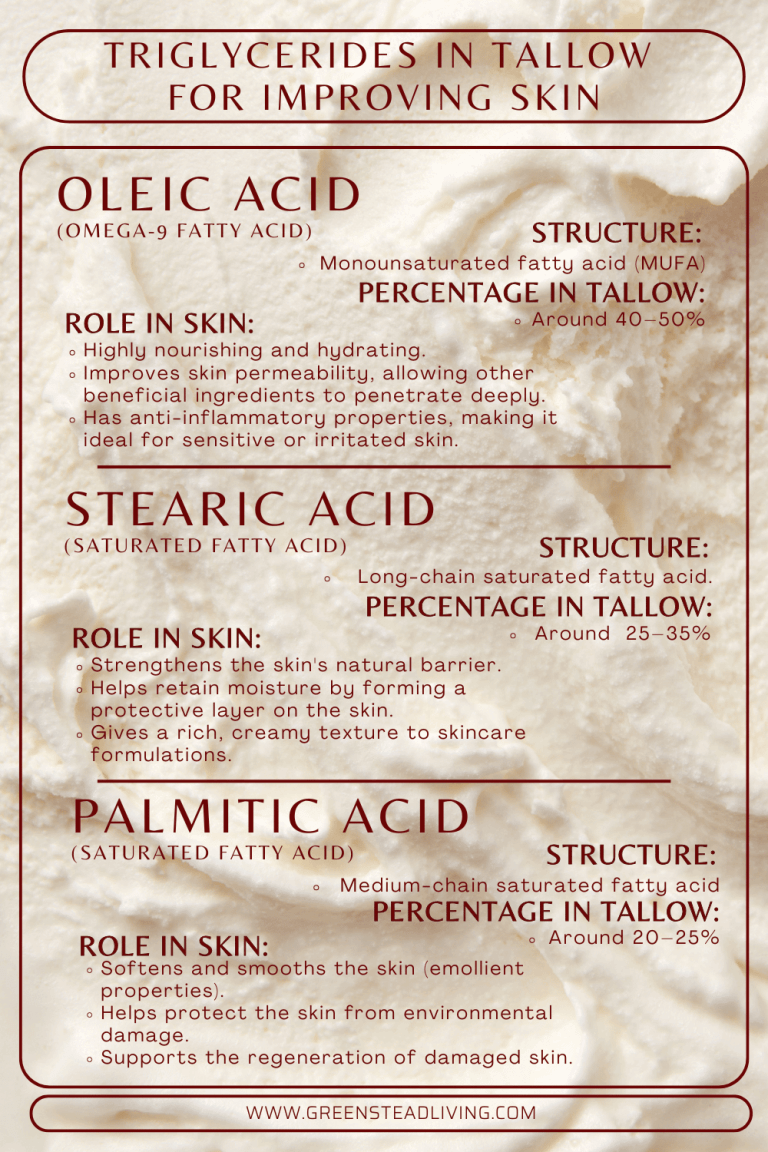
Triglycerides are essential for almost every aspect of skin health, from optimizing the skin’s natural barrier abilities to providing long-lasting hydration by locking in moisture.
Your body naturally produces these triglycerides in sebum—a nourishing oil secreted by the sebaceous glands that moisturizes and protects the skin. While the skin naturally produces triglycerides, external factors like age, diet, environmental stress, and over-cleansing can deplete the skin’s lipid content.
As a result, the true magic of tallow lies not in offering new or exotic compounds but in its ability to mimic and replenish exactly what your skin naturally needs. Tallow seamlessly supplements the skin’s essential components, especially when its natural production is compromised.
By doing so, it helps your skin function at its best, restoring its health and vitality to its peak condition. In essence, tallow gives your skin exactly what it requires to thrive and perform its natural role effectively.
Tallow is not just a great source of fatty acids; it also contains several fat-soluble vitamins that benefit multiple layers of the skin.
Some of the most important essential vitamins include vitamins A, D, K, E, and B12. But how does this translate into better skin?
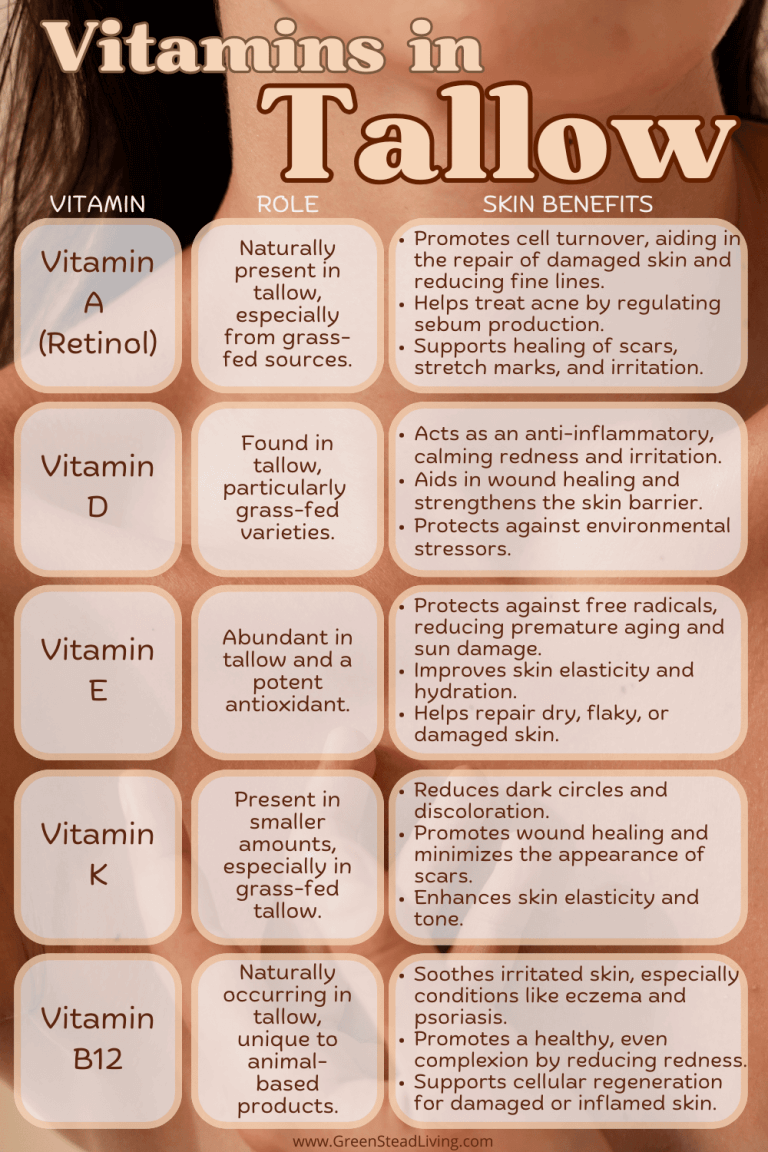
Not all tallow is equal, however. Grass-fed tallow has been consistently shown to contain higher concentrations of these vitamins, making it especially nutrient-dense and beneficial for skin care.
Research from the University of Illinois showed that grass-fed animal fats have 45% less bad fats (PUFAs), 66% less omega-6 (the kind you want less of), and 4 times more omega-3 (the good stuff).
The balance between omega-6 and omega-3 is way better too—grain-fed tallow has over 16 times more omega-6 than omega-3, while grass-fed tallow keeps it nearly even at a healthy 1.4-to-1 ratio.
Grass-fed animals also tend to be pasture-raised in cleaner and more natural environments and are subsequently less likely to be exposed to harmful chemicals, antibiotics, and hormones.
Choosing your source of tallow moisturizer is therefore of critical importance – selecting the right source for your tallow can make the difference between seeing no benefits at all and achieving truly remarkable results.
By replenishing essential compounds naturally found in healthy skin—like triglycerides, vitamins, and beneficial fatty acids—applying tallow can unlock a range of benefits, helping your skin perform at its peak, as it would if you were in your 20’s, had a perfect diet, and were not exposed to any environmental toxins.
Best of all, these benefits occur relatively quickly. While it forms a protective and hydrated barrier immediately upon application, longer-term benefits such as clearing dry skin will take between a few days to a couple of weeks.
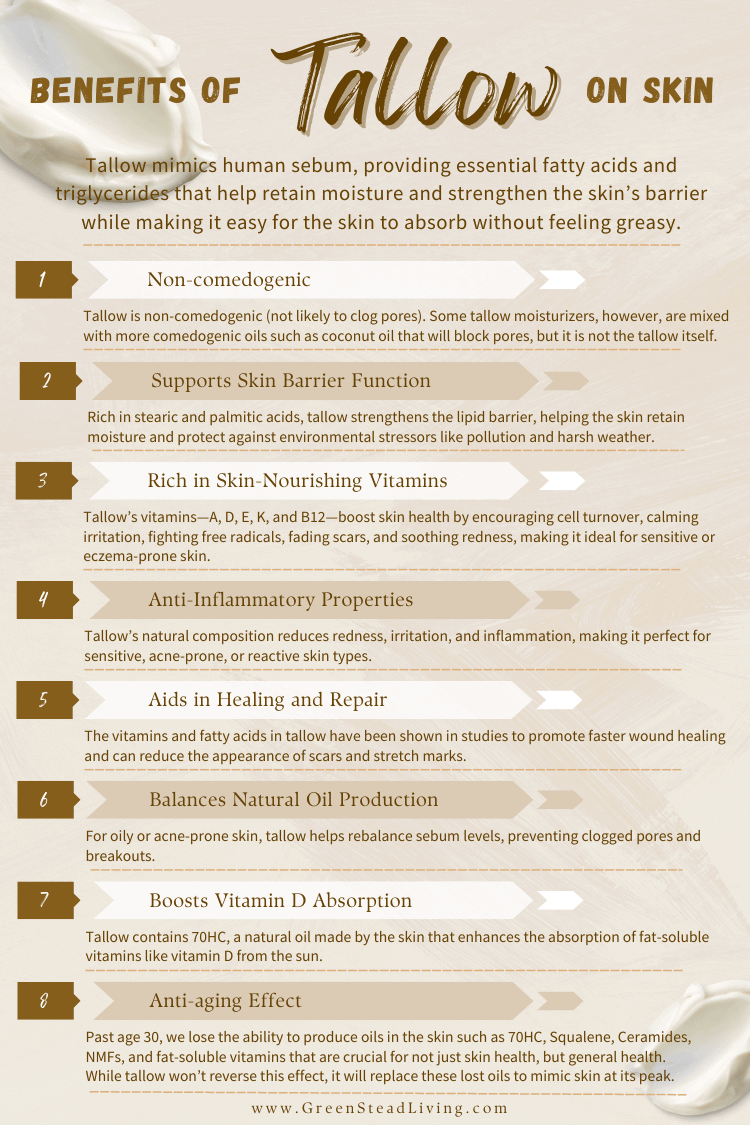
The biggest challenge in skincare is getting products to penetrate the skin’s protective barrier. Skin, like a fortress, has an outer layer called the stratum corneum, which acts as a wall made up of skin cells and lipids (fats) that keep things out. While this barrier keeps harmful invaders like bacteria away, it also makes it hard for moisturizers and other products to reach deeper layers.
For skincare to be effective, products need to either break through this barrier or work within the outer layer. This is why many products use special ingredients to help them penetrate or complement the skin’s natural defenses.
The key components that hold your skin together—cholesterol, fatty acids, and ceramides—are like the nuts and bolts of your skin. While your body can produce these components naturally, its supply isn’t unlimited— factors like stress, illness, or aging, and many skin conditions such as eczema, can reduce their production, weakening the skin’s barrier. Harsh weather and frequent washing can also deplete these components.
That’s where tallow comes in. It helps replenish these essential fatty acids and vitamins, supporting skin health and moisture.
Tallow mostly works on the outer layer of the skin (the epidermis), where it nourishes and protects against dryness and irritation. Some of its nutrients, like vitamins A and E, can go a little deeper to aid in skin repair, but the main benefit is keeping the skin’s surface healthy.
Remember, the main benefits of tallow are to supplement the skin with its natural compounds, such as fatty acids, triglycerides, and vitamins, which maintain skin health, moisture, and nourishment.
As such, there is no need to penetrate too deeply into the skin – most of the benefit is performed in the epidermis, the outermost layer of the skin, where the aim is to restore your skin to a good enough condition for it to all the work itself.
Because tallow is fat, many believe it to not be suitable for many skin conditions, especially acne or for those with oily skin. This is not necessarily true, however – remember, tallow supplements the skin with everything it naturally needs to restore it to its full functional capacity.
Think of moisturizing products as repair kits for your shield. When carefully formulated, these products deliver the missing “building blocks” directly to your skin.
For example, someone with atopic dermatitis might need ceramides, while others may benefit from fatty acids like linoleic acid or arachidonic acid, which help strengthen the barrier.
Although fat-based, tallow has a comedogenic rating of 1-2, meaning it is unlikely to clog pores when used in moderation. For those who have found their tallow moisturizers to block pores and cause spots, the true culprit may be further down the ingredients list.
Beeswax, a common oil found in many tallow moisturizers, has a relatively high comedogenic value of 3. Coconut oil and Cocoa Butter, other popular carrier oils, have a high rating of 4, and maxing out the scale at level 5 are cacao butter and palm oil.
At GreenStead Living, we make our tallow moisturizers by using the minimal amount of jojoba oil necessary to make the tallow spreadable. Jojoba oil has a comedogenic value of just 1, less than tallow itself, ensuring the carrier oil does not add any comedogenic effect.
Properly hydrating the skin poses a hurdle for many individuals, an issue further exacerbated by conditions such as dermatitis or psoriasis. A comparative study looked at the effects of a topical emulsion, which had the main ingredient as tallow.
Specifically, they concluded that the use of high fat-containing emulsions could prove to be helpful in atopic dermatitis or psoriasis. The study included 78 participants, who reported that the moisturizing properties of the emulsion with tallow helped their skin.
A further study also showed the usefulness of a high fat-containing tallow emulsion in providing symptomatic relief to mice with atopic dermatitis.
The study showed the impact of the tallow mixture, which decreased IgE levels (Immunoglobulin E – a type of antibody produced by the immune system) in mice that initially had high IgE levels due to pruritus (a medical term for itching). There was also a decrease in mast cells and B-cell markers.
Another study looked at the benefits of using tallow herbal soap as an anti-infection agent for wound healing versus regular soap.
The herbal soap had good efficacy in fighting skin-infecting bacteria, while also proving to be less drying and damaging to the skin, whereas most chemical soaps tend to dry it out. Thus, the herbal soap showed positive results with anti-aging by retaining moisture rather than depriving it.
These results indicate that there was an anti-inflammatory impact of a tallow emulsion when applied topically to mice, as well as moisturizing properties during wound healing.
No evaluation of the benefits of tallow on the skin would be complete without reviewing any potential side effects.
Not much scientific literature exists, but one study investigated the direct effects of tallow on animal skin and reported that tallow, in a saline solution, topically applied to intact or abraded skin of rabbits for 24 hours did not cause irritation.
Even when applied to their eyes following a rinse or no-rinse, no irritation was found. Also, when applied topically to the skin of guinea pigs, it did not cause any type of hypersensitivity reaction in guinea pigs, and there was no associated genotoxicity or carcinogenicity.
These studies also found no evidence of genotoxicity, carcinogenicity, reproductive toxicity, or embryo-fetal development toxicity in tallow when applied topically in moderate amounts. This makes it safe for long-term use in properly formulated products.
The effects of tallow depend heavily on its formulation and concentration. Pure or highly concentrated derivatives (like POE-T) are associated with more severe irritation and toxicity. However, these effects are significantly reduced when tallow is diluted or mixed into a balanced moisturizer.
For natural moisturizers using natural forms of tallow, there shouldn’t be any real side effects.
Beef tallow might not be the first ingredient that comes to mind when you think of glowing skin, but it sure knows how to bring the nourishment and hydration your skin craves.
Packed with essential fatty acids, vitamins, and the kind of nutrients your skin loves, tallow has earned its place as a skincare hero. Think of it as your skin’s personal repair kit, working hard to restore balance and help you glow like the best version of yourself—without the need for a fancy name or a skincare celebrity endorsement.
Give it a try, and let your skin feel the love from this ancient yet modern marvel. Just remember, it’s not about what’s on the outside, it’s about what’s inside—and in this case, that means a little beefy goodness for your skin!
By replenishing essential compounds naturally found in healthy skin—like triglycerides, vitamins, and beneficial fatty acids—applying tallow can unlock a range of benefits, helping your skin perform at its peak, as it would if you were in your 20’s, had a perfect diet, and were not exposed to any environmental toxins.
Best of all, these benefits occur relatively quickly. While it forms a protective and hydrated barrier immediately upon application, longer-term benefits such as clearing dry skin will take between a few days to a couple of weeks.
Although fat-based, tallow has a comedogenic rating of 1-2, meaning it is unlikely to clog pores when used in moderation. For those who have found their tallow moisturizers to block pores and cause spots, the true culprit may be further down the ingredients list.

Here are the 5 best companion plants for strawberries, and how each will compliment each other for healthier and more lucrative strawberries.

Here is a comprehensive and easy to follow companion planting chart for vegetables, based on available scientific literature and trial and error experience.

Here is a list of the 5 best companion plants for cucumbers that will help your cucumbers, and your garden as a whole, thrive.
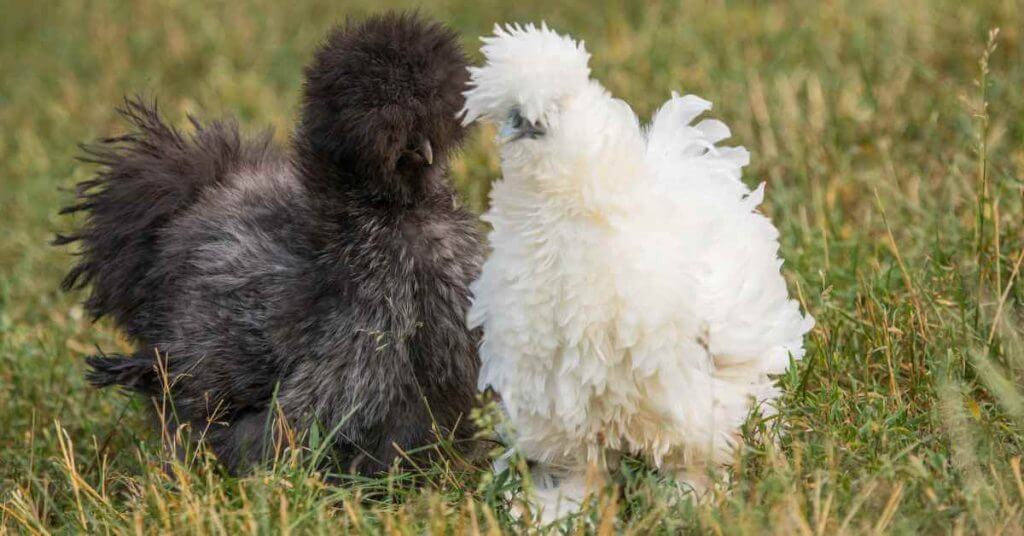
A guide to Silkie chickens and everything you need to know about the breed before you buy.

Learn how to preserve eggs for long term use, using the age-old technique of water glassing.

Here are the 5 best companion plants for peppers that will deter pests, attract pollinators, increase fruit set and yield, and enable your peppers to thrive.